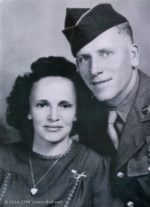George Valentine Lacher was born on Feb 15, 1914, in Harlem Hospital, Manhattan, New York. His single mother was unable to care for him, so she surrendered him to The New York Foundling Hospital, an orphanage run by Catholic nuns.
George lived at the orphanage until he was 11 years old. That year a childless couple, Frank and Julia Lacher, sent a request (through their local priest) to The New York Foundling Hospital for an older male child.
On May 18, 1925, George arrived on an Orphan Train in Anselmo, Nebraska, where he met his future parents (the Lacher’s) for the first time. The train was filled with other orphans from New York City who (unless they had a destination, like George did) would be lined up along the railroad station at each train stop. The townspeople would come out and pick out a child, if they wanted one. Sometimes the children were instructed to perform dances or sing to appeal to the townspeople. Thankfully, George did not have to participate in that emotionally-charged and often-repeated show.
George had a happy life with the Lachers, who eventually adopted George. He rode a horse to school, was musically active, played on the high school football team, and did well in school.
He married Geraldine Jacquot at 19 years old, in 1933. Ten years later, they had six children and were living in Avon, Colorado, where George farmed.
George enlisted on Apr 28, 1944, from Denver, Colorado. He was assigned to the Infantry, 95th Division, 379th Infantry Regiment, Company C. During the Lorraine Campaign, as the company pushed from France, across the Saar river into Germany, they took heavy fire from the Germans.
Before daylight on December 5th, George’s battalion attacked Saarlautern-Roden. During the early morning crossing, there were brief small arms fires. But then reaching pillboxes outside the village of Ensdorf, enemy fire became much worse. They moved forward slowly, crossing the railroad line south of the village. As they moved towards Saarlautern-Roden, they took heavy fire from pillboxes (built into the streets and between houses), manned by machine gun crews. In Saarlautern-Roden, Fraulautern, and Ensdorf, Germans fought back every yard of ground. Every time the 95th would take a pillbox, the Germans would filter behind American lines in small groups, forcing the 95th to turn back and regroup. By doing this, the 95th re-fought to take ground two or three times, until they decided to weld the doors shut on the pillboxes. The 95th took intense fire from the Germans—-at one point it took 1,500 rounds of fire in only three hours. In that attack, the 95th captured seven forts and several blocks of the city, but it cost many casualties, including George's life.
As the remaining infantrymen continued the attack in Saarlautern-Roden, enemy artillery and mortar fire became lighter around the bridge area. By the night of Dec 5th, 1944, the battalion received orders that they would be relieved the next day.
By mid-December the "Iron Men of Metz" had lost so many valiant men in the 95th that the remaining soldiers were pulled back to the west bank of the Saar.
His body was transported from Germany to France. He was originally buried in Lorraine American Cemetery in St Avold (27 km from where George fell). He was buried in Plot S, Row 9, Grave 218. Some years later, his body was moved to Anselmo, Nebraska, to a family plot.
George was killed in action at 29 years old in Germany less than 7 months after enlisting. He left behind a 29 year old wife and six children who barely knew him.
The cost of freedom is high.
Before daylight on December 5th, George’s battalion attacked Saarlautern-Roden. During the early morning crossing, there were brief small arms fires. But then reaching pillboxes outside the village of Ensdorf, enemy fire became much worse. They moved forward slowly, crossing the railroad line south of the village. As they moved towards Saarlautern-Roden, they took heavy fire from pillboxes (built into the streets and between houses), manned by machine gun crews. In Saarlautern-Roden, Fraulautern, and Ensdorf, Germans fought back every yard of ground. Every time the 95th would take a pillbox, the Germans would filter behind American lines in small groups, forcing the 95th to turn back and regroup. By doing this, the 95th re-fought to take ground two or three times, until they decided to weld the doors shut on the pillboxes. The 95th took intense fire from the Germans—-at one point it took 1,500 rounds of fire in only three hours. In that attack, the 95th captured seven forts and several blocks of the city, but it cost many casualties, including George's life.
As the remaining infantrymen continued the attack in Saarlautern-Roden, enemy artillery and mortar fire became lighter around the bridge area. By the night of Dec 5th, 1944, the battalion received orders that they would be relieved the next day.
By mid-December the "Iron Men of Metz" had lost so many valiant men in the 95th that the remaining soldiers were pulled back to the west bank of the Saar.
His body was transported from Germany to France. He was originally buried in Lorraine American Cemetery in St Avold (27 km from where George fell). He was buried in Plot S, Row 9, Grave 218. Some years later, his body was moved to Anselmo, Nebraska, to a family plot.


